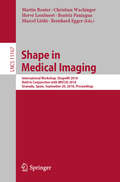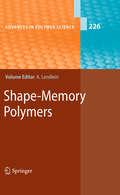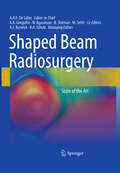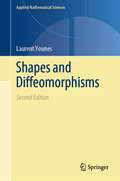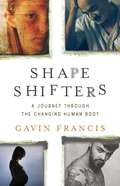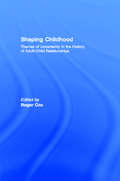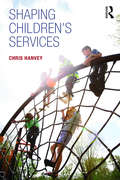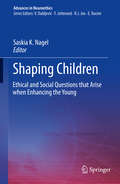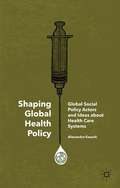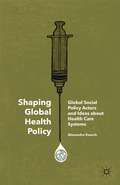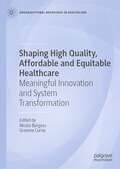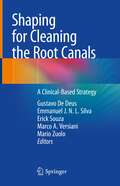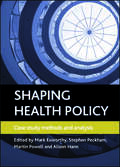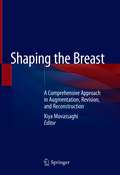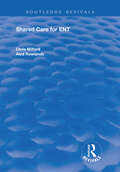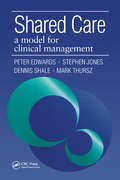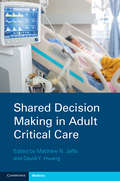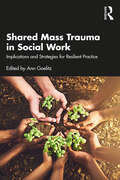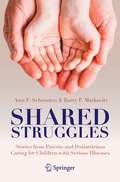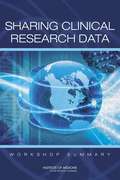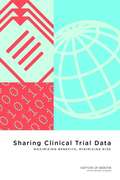- Table View
- List View
Shape in Medical Imaging: International Workshop, ShapeMI 2018, Held in Conjunction with MICCAI 2018, Granada, Spain, September 20, 2018, Proceedings (Lecture Notes in Computer Science #11167)
by Martin Reuter Christian Wachinger Hervé Lombaert Beatriz Paniagua Marcel Lüthi Bernhard EggerThis book constitutes the proceedings of the Workshop on Shape in Medical Imaging, ShapeMI 2018, held in conjunction with the 21st International Conference on Medical Image Computing, MICCAI 2018, in Granada, Spain, in September 2018. The 26 full papers and 2 short papers presented were carefully reviewed and selected for inclusion in this volume. The papers discuss novel approaches and applications in shape and geometry processing and their use in research and clinical studies and explore novel, cutting-edge theoretical methods and their usefulness for medical applications, e.g., from the fields of geometric learning or spectral shape analysis.
Shape-Memory Polymers
by Andreas LendleinTable of Contents -Shape-Memory Polymers and Shape-Changing Polymers By M. Behl, J. Zotzmann, and A. Lendlein -Shape-Memory Polymer Composites By Samy A. Madbouly and Andreas Lendlein -Characterization Methods for Shape-Memory Polymers By W. Wagermaier, K. Kratz, M. Heuchel, and A. Lendlein -Shape-Memory Polymers for Biomedical Applications By Christopher M. Yakacki and Ken Gall -Controlled Drug Release from Biodegradable Shape-Memory Polymers By ChristianWischke, Axel T. Neffe, and Andreas Lendlein
Shaped Beam Radiosurgery
by Antonio A. De Salles Alessandra Gorgulho Michael Selch Raymond Schulz Aaron J. Burwick Nzhde Agazaryan Ben SlotmanNovalis® Shaped Beam Radiosurgery has set new standards by delivering highly precise radiation treatments to tumors anywhere in the body through the use of a proprietary multileaf collimator. By shaping the radiation beam to the exact contours of the tumor or lesion, Novalis permits maximum dose delivery to the entire tumor while protecting healthy tissue; this makes it eminently suitable for the treatment of irregularly shaped tumors. This book provides a complete guide to radiosurgery treatments with Novalis. After a thorough discussion of the clinical and technical basis for Shaped Beam Radiosurgery, current clinical applications are considered in detail, including brain, body, skull base, and spinal tumors as well as arteriovenous malformations. Careful consideration is also given to future developments and applications, including new technologies that promise to offer even more accurate treatments. This state-of-the-art book will appeal to a wide audience of physicians and their multidisciplinary clinical and technical collaborators.
Shapes and Diffeomorphisms (Applied Mathematical Sciences #171)
by Laurent YounesThis book covers mathematical foundations and methods for the computerized analysis of shapes, providing the requisite background in geometry and functional analysis and introducing various algorithms and approaches to shape modeling, with a special focus on the interesting connections between shapes and their transformations by diffeomorphisms. A direct application is to computational anatomy, for which techniques such as large‒deformation diffeomorphic metric mapping and metamorphosis, among others, are presented. The appendices detail a series of classical topics (Hilbert spaces, differential equations, Riemannian manifolds, optimal control).The intended audience is applied mathematicians and mathematically inclined engineers interested in the topic of shape analysis and its possible applications in computer vision or medical imaging. The first part can be used for an advanced undergraduate course on differential geometry with a focus on applications while the later chapters are suitable for a graduate course on shape analysis through the action of diffeomorphisms. Several significant additions appear in the 2nd edition, most notably a new chapter on shape datasets, and a discussion of optimal control theory in an infinite-dimensional framework, which is then used to enrich the presentation of diffeomorphic matching.
Shapeshifters: A Journey Through the Changing Human Body
by Gavin FrancisFrom birth to death, a lyrical exploration of the role of transformation in human lifeTo be alive is to be in perpetual metamorphosis: growing, healing, learning, aging. In Shapeshifters, physician and writer Gavin Francis considers the inevitable changes all of our bodies undergo--such as birth, puberty, and death, but also laughter, sleeping, and healing-and those that only some of our bodies will: like getting a tattoo, experiencing psychosis, suffering anorexia, being pregnant, or undergoing a gender transition. In Francis's hands, each event becomes an opportunity to explore the meaning of identity and the natures-biological, psychological, and philosophical-of our selves. True to its own subject, Shapeshifters combines Francis's lyrical imagination and deep knowledge of medicine and the humanities for a life-altering read.
Shaping Childhood: Themes of Uncertainty in the History of Adult-Child Relationships
by Roger CoxWhat part has religion played in the history of child-rearing? How do we persuade children to behave rationally and how should we exercise adult authority? What use do we make of their innocence and how do we cope with their sexuality? Has history left us with ideas about the child which make no sense in the prevailing conditions of the late twentieth century? In Shaping Childhood these questions are explored through themes from the history of childhood. The myth of the repressive Puritan parent is explored by looking at Puritan ideals of child-rearing. Treating the child as if it were rational seemed to Locke the best way to approach child-rearing, but Rousseau was sceptical of adult manipulation and Romanticism could be subversive of both religion and reason as sources of discipline in child-rearing. The Victorians inherited many of the contradictions these approaches gave rise to, and they added a complication of their own through an aesthetic response to childhood's beauty. Currently, with instability in household formation and with the child exposed to ever more sophisticated means of communication, parents, teachers and others struggle to make sense of this ambiguous historical legacy. Shaping Childhood examines the ways in which broad cultural forces such as religion, literature and mass consumption influence contemporary parenting and locates child professionals, within the context of these forces.
Shaping Children's Services
by Chris HanveyThis text is an authoritative analysis of current services for children and young people in the UK. Drawing upon European-wide data, this innovative book critiques the policies that have shaped today’s services, argues that the current system is insufficiently joined-up and outlines a radical new model of co-located services for the integrated delivery of children’s care. Shaping Children’s Services: examines key indicators of children’s development; provides a breakdown of the economics of caring for children; explores the way government initiatives such as Sure Start, Extended Schools, Total Place and the Kennedy review of children’s health have shaped current policies; charts the key twentieth-century developments of child welfare across health, education and social care and looks at the inter-relationships between health, social care, police, education and the voluntary sector; presents both good and failing examples of children’s services. Offering a thoughtful and provocative challenge on how the present system can be better configured to meet the needs of children and young people, this book is an essential read for all those involved in working with children from a range of fields, including health, education, social care, juvenile justice and voluntary sector services.
Shaping Children: Ethical and Social Questions that Arise when Enhancing the Young (Advances in Neuroethics)
by Saskia K. NagelThe volume offers a unique collection of articles on pediatric neuroenhancement from an international and multidisciplinary perspective. In recent years, the topic of “neuroenhancement” has become increasingly relevant in academia and practice, as well as among the public. While autonomous adults are free to choose neuroenhancement, in children it presents its own ethical, social, legal, and developmental issues. A plethora of potential (neurotechnological) enhancement agents are on the market. While the manifold issues surrounding the topic have been extensively discussed, there is little work on the specific questions that arise in children and adolescents. This book addresses this gap in the literature: Next to conceptual and normative work on autonomy and self-control, the collection explores the implications for parenting and schooling, and provides input for a discussion of public attitudes. It is a valuable resource for the different academic communities confronted with questions of how to evaluate and approach enhancement in children and is of interest to neuroethicists, scholars in applied ethics and neurology, psychiatrists and psychologists as well as scientists developing enhancement interventions for children.
Shaping Global Health Policy: Global Social Policy Actors and Ideas about Health Care Systems
by Alexandra KaaschUsing an approach that combines transnational and comparative social policy analysis with international relations, this book assesses various global social policy actors and compares their ideas and prescriptions about national health care systems. It highlights the importance of considering health policies across multiple scales.
Shaping Global Health Policy: Global Social Policy Actors and Ideas about Health Care Systems
by Alexandra KaaschUsing an approach that combines transnational and comparative social policy analysis with international relations, this book assesses various global social policy actors and compares their ideas and prescriptions about national health care systems. It highlights the importance of considering health policies across multiple scales.
Shaping High Quality, Affordable and Equitable Healthcare: Meaningful Innovation and System Transformation (Organizational Behaviour in Healthcare)
by Graeme Currie Nicola BurgessHealthcare systems around the world are struggling under intense pressure. Ageing populations, declining workforce, funding restraints and spending cuts have combined to produce a challenging environment to deliver a service that is fundamental to the lives of many. This book defines sustainable healthcare as an integrated system, where stakeholders work together to deliver high quality, safe patient care at the lowest possible cost and with a focus on outcomes that patients value. Using this definition as a guide, this book brings together an extensive body of knowledge from an elite group of academics to consider how we can shape healthcare service delivery in a way that delivers sustainable value to society as a whole.This edited collection will be of interest to academics working in healthcare management, healthcare innovation, the role of technology in healthcare, sustainable healthcare management, and healthcare in public policy. It will also be vital reading for managers and professionals working in health and social care that are interested in research -based solutions to the challenges they face.
Shaping Long-Term Care in Emerging Asia: Policy and Country Experiences (Routledge Advances in Asia-Pacific Studies)
by Vasoontara Sbirakos YiengprugsawanCountries are facing increasing life expectancy and a shrinking family size and in effect, this may escalate demands for medical and supportive services. The role of families in providing informal care will remain important. However, the simultaneous decline in the supply of informal caregiving caused by changes in family structure and higher female labour-market participation necessitate the expansion of the public role in care provision. This book analyses the challenges of long-term care (LTC) policy development and implications from advanced LTC systems and a current trajectory in emerging economies in Asia. The book approaches the subject through comparative analysis on what works and what does not to provide insight into public policy options for sustainable LTC provision and financing mechanisms. How the countries adopt different approaches to health and social systems towards LTC development could provide important insight and perspectives into policy options in the region. This book aims at academics, policymakers and practitioners in health, social, and aged care services and could also be used as a teaching resource for undergraduate students in health and social sciences and postgraduate programs in public health, epidemiology, social demography, gerontology, and nursing. The book will be of interest to a wider audience not only on social and health consequences of population ageing but also health and social policy relating to older persons.
Shaping for Cleaning the Root Canals: A Clinical-Based Strategy
by Marco A. Versiani Gustavo De Deus Emmanuel J. N. L. Silva Erick Souza Mario ZuoloThis book provides clinicians with up-to-date, scientifically based guidance on the most important stages of endodontic treatment, i.e., cleaning and shaping of the root canal space, including mechanical preparation and chemical disinfection. Five internationally recognized experts present and discuss recent developments and new perspectives in the field. Important advances in root canal preparation and irrigation procedures are described with the aid of numerous high-quality illustrations. A key feature of the book is the detailed attention devoted to the latest research findings and to their impact on contemporary evidence-based clinical guidelines and modern clinical practice. On this basis, simple treatment protocols are proposed that take the anatomy of the root canals fully into account. In addition, emerging problems and trends are considered. The book will be an excellent resource for clinicians and advanced practitioners who are seeking to update their practice.
Shaping health policy: Case study methods and analysis
by Mark Exworthy, Stephen Peckham, Martin Powell and Alison HannThis collection examines the role that case-studies play in understanding and explaining British health policy. Overall, the chapters cover the key health policy literatures in terms of the policy process, analytical frameworks and some of the seminal moments of the NHS. They have been written by leading health policy researchers in sociology, social policy, management and organisation studies. The collection explores and promotes the case-study as an under-used method and thereby encourages a more reflective approach to policy learning by practitioners and academics. The book will appeal to under-graduates, post-graduates and academics in social policy, public management and health services research.
Shaping the Breast: A Comprehensive Approach in Augmentation, Revision, and Reconstruction
by Kiya MovassaghiThis book fills the gap for lack of a precise roadmap to approach the fundamentals of implant-based breast surgery to achieve optimal results. Despite the vast number of publications on breast surgery, there is a deficit in easy to process yet detailed source of information which brings all of the concepts together. With observation, surgical experience, and better devices the approach to implant-based breast surgery must evolve from “volumizing” the breast to “shaping” the breast. In a concise and accessible fashion, Shaping the Breast covers the best practices in breast surgery covering topics of primary augmentation, augmentation mastopexy, composite augmentation, revision breast surgery and breast reconstruction. In a methodical and logical approach, it provides the successful pillars for reproducible outcomes which includes patient assessment, biodimensional planning, surgical techniques and patient care along with pearls and pitfalls. It includes dozens of before and after images alongside case studies to illustrate the management of variety of complex issues.
Share Economy im Gesundheitswesen: Auf dem Weg zum dritten Gesundheitsmarkt (essentials)
by David MatusiewiczDas vorliegende essential handelt vom dritten Gesundheitsmarkt. Damit ist ein Markt gemeint, indem das Teilen (Share Economy) von beispielsweise Daten gegen eine Gesundheitsdienstleistung im Vordergrund steht. In diesem Marktumfeld kann die Autonomie der Patienten unterstützt werden und zu einer verbesserten und bedarfsgerechten Versorgung führen. Sie lernen hierbei die Abgrenzung zum bestehenden ersten und zweiten Gesundheitsmarkt kennen und erhalten einen kritischen Überblick über die Chancen und Grenzen der Share Economy im Gesundheitswesen.
Share the Care
by Cappy Capossela Sheila Warnock Sukie MillerYou Don't Have to Do It Alone Whether you're prepared for it or not, chances are you'll take on the role of caregiver when a family member or friend is affected by a serious illness or injury, or when you find your elderly parent needs help. As you'll soon discover, the range of tasks and responsibilities involved are overwhelming. Share The Care offers a sensible and loving solution: a unique group approach that can turn a circle of ordinary people into a powerful caregiving team. Share The Care shows you how to: Create a caregiver "family" from friends, real family members, neighbors, coworkers, and acquaintances. Hold a meeting to organize your group, and introduce members to the Share The Care systems that guarantee every job will be done and no one person will have to do too much. Discover the hidden talents within the group, make the most of their resources, cope with group issues, and stay together in the face of adversity. Included here are valuable guidelines, compassionate suggestions, and a simple-to-use workbook section that together offer support to free the patient from worry and the caregivers from burnout. Share The Care offers friends and family the best answer ever to the frequently asked question "What can I do?"
Shared Care For ENT
by Chris Milford Aled RowlandsThis book provides clear, practical advice on the management of ENT disorders through a `shared care' approach. The emphasis throughout the text is on the recognition of symptoms and signs to provide accurate clinical diagnosis, with guidelines on which patients to refer to a specialist unit and which patients can be managed safely within the primary care surgery Other topics dealt with include the use of therapeutics, instrumentation, and the management of both adult and paediatric disorders.
Shared Care: A Model for Clinical Management
by Peter Edwards Jones Stephen Dennis Shale Mark ThurszUsing practical examples this book demonstrates how a theoretical model for shared care operates in practice to deliver improved health outcomes within limited resources. It shows how clinically-led initiatives can influence health care commissioning strategies and how the implementation of the model meets the needs of clinicians purchasers and providers. The model and evaluation protocols advocated here provide a firm foundation for the development of shared care in the future.
Shared Decision Making in Adult Critical Care
by Matthew N. Jaffa David Y. HwangThe adult critical care setting requires complex clinical decisions to be made that have a dramatic impact on the lives of patients and their families. This textbook offers evidence-based case histories around shared decision making, providing practical advice to clinicians who are trying to navigate routine clinical scenarios in adult critical care. Early chapters explore the definition of the shared decision making process and practical steps that aid its implementation. The greater part of the book focuses on how shared decision making can be practiced in specific situations that are common in adult critical care, highlighting the relevant knowledge base necessary to manage each situation. Do-not-resuscitate and do-not-intubate orders, ECMO, and resolving conflicts regarding potentially inappropriate treatment are among the topics covered. An essential resource for healthcare professionals working in critical care and those looking for a framework for the use of shared decision making in this setting.
Shared Mass Trauma in Social Work: Implications and Strategies for Resilient Practice
by Ann GoelitzThis edited volume looks at the phenomenon of shared trauma and how it affects social workers and their clients alike. Bringing together established voices from the field of social work, Shared Mass Trauma in Social Work presents ideas of how to provide resilient care and practice while social workers and their clients are both experiencing the same mass trauma. Social workers are often on the front line when community trauma occurs, and the boundary between their experiences and those of clients can become blurred. In this timely resource, Ann Goelitz and the contributors aim to share both their findings and evidence-based tools to help professionals look after themselves and their clients in times of turmoil. Beginning by setting a conceptual framework for shared trauma and reviewing related research, the contributors discuss the concept as it relates to events such as the coronavirus pandemic, climate change and natural disasters, police brutality and racism, and war and terrorism. Filled with case studies that bring the text to life, chapters then move to the modalities of psychotherapy, group work, and community organizing, before concluding with reflections and lessons learnt for future practice. The glossary of terms, sample syllabus, and practical exercises to support training social workers are a bonus for educators. Shared Mass Trauma in Social Work incorporates specific implications, trauma-informed care, social work principles, and practical tips to support training and established clinicians working in unprecedented circumstances.
Shared Physical Custody: Interdisciplinary Insights in Child Custody Arrangements (European Studies of Population #25)
by Laura Bernardi Dimitri MortelmansThis open access book provides an overview of the ever-growing phenomenon of children in shared physical custody thereby providing legal, psychological, family sociological and demographical insights. It describes how, despite the long evolution of broken families, only the last decade has seen a radical shift in custody arrangements for children in divorced families and the gender revolution in parenting which is taking place. The chapters have a national or cross-national perspective and address topics like prevalence and types of shared physical custody, legal frames regulating custody arrangements, stability and changes in arrangements across the life course of children, socio‐economic, psychological, social well-being of various family members involved in different custody arrangements. With the book being an interdisciplinary collaboration, it is interesting read for social scientists in demography, sociology, psychology, law and policy makers with an interest family studies and custody arrangements.
Shared Struggles: Stories from Parents and Pediatricians Caring for Children with Serious Illnesses
by Ann F. Schrooten Barry P. MarkovitzThis book tells true and poignant stories from both sides of the physician-patient/parent relationship and provides a unique glimpse into how parents and physicians think, feel, and interact. The stories are grouped under four sections: Hope, Compassion, Communication, and Trust. Each section includes stories contributed by parents from all across the United States and by pediatricians practicing at many of the best children’s hospitals throughout the country. The parents tell of interactions with physicians that had a significant impact on them and their child and offer context and insight that promote empathy and reflection. The physicians tell of interactions with patients and families that served as learning moments in their career and promote the humanization of medicine and show there is more to a physician beyond their scientific knowledge and white coat. The stories are edited by Barry P. Markovitz - a pediatrician specializing in critical care medicine who has been in practice for more than 20 years and by Ann F. Schrooten - the parent of a child born with a chronic complex condition who has more than 15 years of experience interacting with pediatric subspecialists and other healthcare professionals who cared for her son. The editors have written commentaries to the stories to provide an independent perspective on the events and messages conveyed and to encourage reflection, inquiry, and discussion. In addition to being a valuable resource for pediatricians, pediatric subspecialists, nurses and other healthcare professionals, the book will also appeal to families of children living with complex medical conditions because it shares physician encounters and behaviors many have experienced in the care of their own children. By giving a voice to both parents and physicians, the goal is to create a bridge to better understanding that can improve communication, minimize conflicts, and foster trust and compassion among physicians, patients, and families.
Sharing Clinical Research Data
by Institute of Medicine Steve Olson Board on Health Care Services Forum on Drug Discovery, Development, and Translation Board on Health Sciences Policy National Cancer Policy Forum Forum on Neuroscience and Nervous System Disorders Roundtable on Translating Genomic-Based Research on Health Autumn S. DowneyPharmaceutical companies, academic researchers, and government agencies such as the Food and Drug Administration and the National Institutes of Health all possess large quantities of clinical research data. If these data were shared more widely within and across sectors, the resulting research advances derived from data pooling and analysis could improve public health, enhance patient safety, and spur drug development. Data sharing can also increase public trust in clinical trials and conclusions derived from them by lending transparency to the clinical research process. Much of this information, however, is never shared. Retention of clinical research data by investigators and within organizations may represent lost opportunities in biomedical research. Despite the potential benefits that could be accrued from pooling and analysis of shared data, barriers to data sharing faced by researchers in industry include concerns about data mining, erroneous secondary analyses of data, and unwarranted litigation, as well as a desire to protect confidential commercial information. Academic partners face significant cultural barriers to sharing data and participating in longer term collaborative efforts that stem from a desire to protect intellectual autonomy and a career advancement system built on priority of publication and citation requirements. Some barriers, like the need to protect patient privacy, pre- sent challenges for both sectors. Looking ahead, there are also a number of technical challenges to be faced in analyzing potentially large and heterogeneous datasets. This public workshop focused on strategies to facilitate sharing of clinical research data in order to advance scientific knowledge and public health. While the workshop focused on sharing of data from preplanned interventional studies of human subjects, models and projects involving sharing of other clinical data types were considered to the extent that they provided lessons learned and best practices. The workshop objectives were to examine the benefits of sharing of clinical research data from all sectors and among these sectors, including, for example: benefits to the research and development enterprise and benefits to the analysis of safety and efficacy. Sharing Clinical Research Data: Workshop Summary identifies barriers and challenges to sharing clinical research data, explores strategies to address these barriers and challenges, including identifying priority actions and "low-hanging fruit" opportunities, and discusses strategies for using these potentially large datasets to facilitate scientific and public health advances.
Sharing Clinical Trial Data: Maximizing Benefits, Minimizing Risk
by Committee on Strategies for Responsible Sharing of Clinical Trial DataData sharing can accelerate new discoveries by avoiding duplicative trials, stimulating new ideas for research, and enabling the maximal scientific knowledge and benefits to be gained from the efforts of clinical trial participants and investigators. At the same time, sharing clinical trial data presents risks, burdens, and challenges. These include the need to protect the privacy and honor the consent of clinical trial participants; safeguard the legitimate economic interests of sponsors; and guard against invalid secondary analyses, which could undermine trust in clinical trials or otherwise harm public health. "Sharing Clinical Trial Data" presents activities and strategies for the responsible sharing of clinical trial data. With the goal of increasing scientific knowledge to lead to better therapies for patients, this book identifies guiding principles and makes recommendations to maximize the benefits and minimize risks. This report offers guidance on the types of clinical trial data available at different points in the process, the points in the process at which each type of data should be shared, methods for sharing data, what groups should have access to data, and future knowledge and infrastructure needs. Responsible sharing of clinical trial data will allow other investigators to replicate published findings and carry out additional analyses, strengthen the evidence base for regulatory and clinical decisions, and increase the scientific knowledge gained from investments by the funders of clinical trials. The recommendations of "Sharing Clinical Trial Data" will be useful both now and well into the future as improved sharing of data leads to a stronger evidence base for treatment. This book will be of interest to stakeholders across the spectrum of research--from funders, to researchers, to journals, to physicians, and ultimately, to patients.
